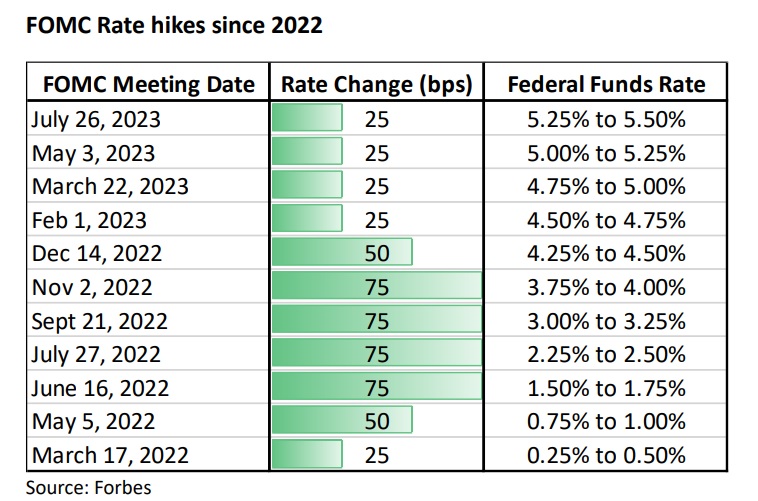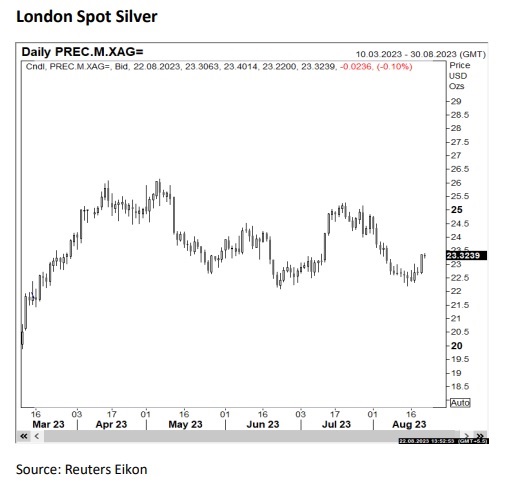Gold and silver prices fell considerably in the past few weeks and the outlook seems grim. Expectations of more rate hikes from the US Federal Reserve, a firmer US currency, and relatively low demand adversely affected the outlook of these precious metals.

Gold
The benchmark London spot gold fell to a five-month low, correcting more than nine percent from May, when it popped to a near-all-time high. A similar selloff was witnessed in domestic gold also. In the futures market, prices edged lower from an all-time high of Rs. 61,845 per ten grams to below Rs. 58,000 last week. Weak overseas sentiments coupled with a decline in demand due to record high prices outweighed the prospects of the commodity.
Fed’s interest rate decision and performance of US Dollar
Market sentiment plays a crucial role in shaping bullion prices. The Federal Reserve’s communication regarding its policies and plans can sway investor confidence and influence the demand for gold as a hedge against economic uncertainty.
The recent buoyant economic data from the US raised bets for higher-for-longer US interest rates, reducing demand for bullion, which does not yield any interest. Besides, the Fed Chair Jerome Powell recently hinted at more rate hike actions in the upcoming meeting. Now, economists foresee a 25-basis point rate increase in its next policy meeting.
The performance of the US dollar is closely linked to US interest rate decisions. The US dollar gained more than 3.6 percent in the last one-month period. The high US greenback usually weighs the outlook on commodities that are denominated in dollars.

Weak domestic demand affected gold prices in India
In the domestic market, the all-time high prices have had a noticeable impact on the physical demand for the commodity. Increased gold rates have reduced the affordability of gold jewellery and deterred consumers from making significant purchases causing a decline in demand.
Higher prices also hampered the investment demand. As a popular investment option, individuals often invest in gold bars, coins, and ETFs as a store of value and a hedge against inflation. However, the high prices have dampened investment demand as potential buyers are reluctant to enter the market at such elevated price levels. Outshining equity markets has also prompted investors to bet on riskier assets in recent times.
The recent jitters affecting China’s economy adversely affect the demand for bullion. The key demand indicator for precious metals in the country suggests a declining demand for the past few months. China is the largest consumer of gold with an average usage of more than 1000 tonnes in the past ten years.
Silver
Silver prices in the overseas market corrected to more than 12 percent in the last one-month period while losses were limited to 9 percent in domestic futures due to a weak Indian Rupee. Prices were dragged down by concerns over Chinese demand, and a strong recovery in US yields.
Though silver has both industrial and investment applications, industrial uses of this metal have remarkably increased in the past few years. Almost 60 percent of global consumption of silver is accounted for industrial usage and the rest is for investment purposes.

Feeble demand outlook from China
China plays an increasingly important role in the global silver industry. However, the recent string of downbeat economic releases from China highlighted intensifying pressure on their economy and thus the demand for silver. After witnessing an initial rebound in the first quarter, China’s economy has come to grips with long-standing problems and slowing global demand for its products.
All the key activity indicators have undershot consensus expectations in recent months. A weaker-than-expected retail sales, industrial production, and fixed asset investment numbers indicate that the world’s second-largest economy is slowing down.
The balance between demand-supply would be a significant driver for prices. As per the Silver Institute data, global silver demand outpaces supply. Silver demand has increased by 38% since 2020 while production recorded a shortfall.
Meanwhile, there are new industrial demand areas for silver have emerged driven by advances in technology and changes in consumer behaviour. Electrification within the automotive segment and other power generation and distribution investments contribute to the same largely.
Outlook
Looking ahead, the ongoing geopolitical and economic uncertainties like higher inflation, economic jitters in China, and the pandemic-related economic distortions amid the Russia – Ukraine war continue to offer support to the safe haven status of gold and silver. Hopes of a physical demand recovery from China and India may also contribute to the trend. However, traders remain cautious while taking big bets due to the higher yield of US assets and the chances of further interest rate hikes from the US Federal Reserve.







